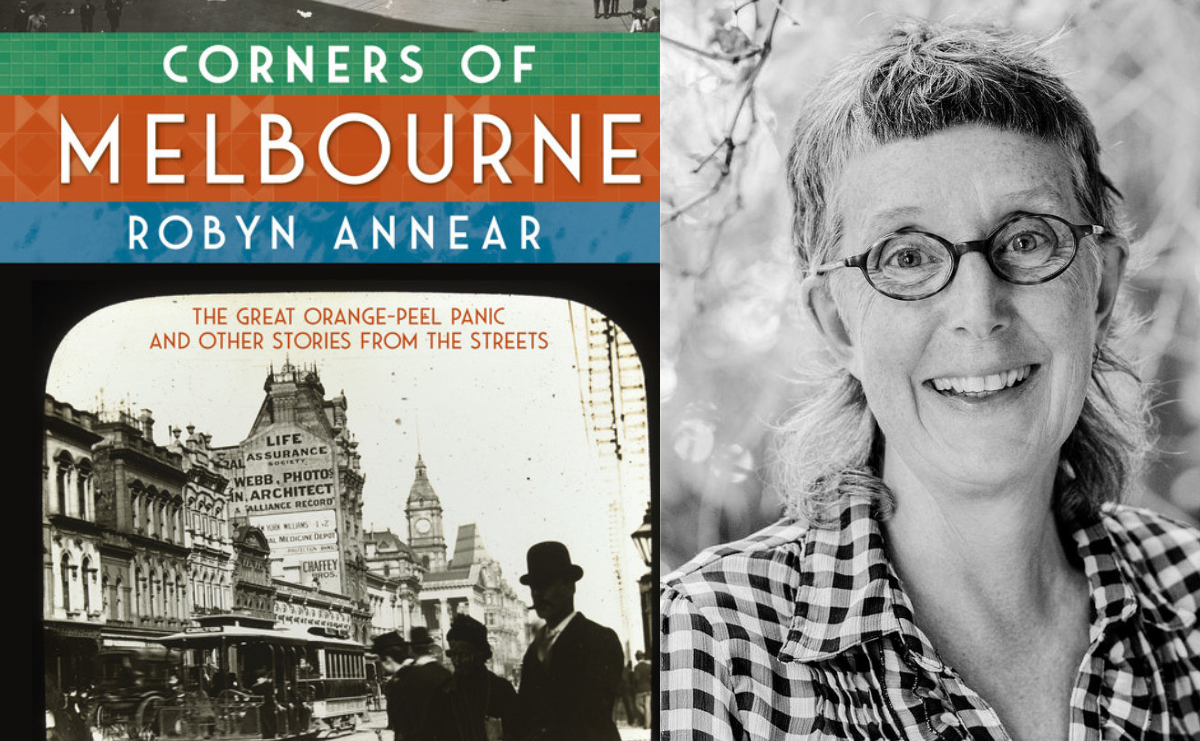The dictionary definition of a corner as a place or angle where two sides or edges meet hardly does the concept justice. Robyn Annear says it so much better when she describes city corners as ‘the prime locus for collisions, confrontations, ambushes – encounters of all kinds’.
Indeed Corners of Melbourne is overflowing with encounters. These are evoked with gusto and brilliance and a depth of understanding of the zeitgeist of the time. And because not everything happens at a corner, Annear has seen herself free to wander more widely.
Annear demonstrates remarkable skill in weaving many anecdotes seamlessly together. She sashays from one episode to the next and inserts her own comments organically into the flow, so what could have read as episodic or lumpy is actually a smooth and fluid reading experience instead.
The book opens with the sad story of a man who broke his leg slipping on an orange peel. This was around 1860 when apparently new flagstone paving stones, combined with discarded orange peels, were a serious hazard. Oranges were a popular snack at the time and peel littered the pavements, with women blamed by the newspapers as the ‘chief strewers of peel’. Apparently, wet weather and leather-soled shoes contributed to many a spill, some serious.
But of course Annear does not limit herself to the danger of oranges. In the second chapter she recounts how runaway horses and speeding carts added to the perils pedestrians faced, particularly at intersections where all road users had equal right of way and speeding cab drivers took no heed of the requirement to slow down to walking speed at crossroads.
By the time I got to the end of the third chapter, which has fountains, and water generally, as its theme, my unrealistic romantic picture of Melbourne was completely shattered. Mid 19th-century Melbourne appeared dangerous and unhygienic, Melbourne’s charming lanes were openly used as pissoirs and the Yarra was unspeakably polluted. The remainder of the book, which includes chapters on larrikins, swindlers and advertisers, does nothing to alter this impression. But I have no doubt a reader better informed than I of Melbourne’s history and of urban life some one and a half centuries ago would not share my disillusionment.
That does not alter the fact that so many of the stories so well-recounted by Annear are of disasters of one kind or another. That is the natural outcome of research necessarily based on newspaper articles, and Annear gives a well-deserved tribute to Trove, but it is hardly surprising that newspaper articles tend to focus on bad news. However, letters published by newspapers and quoted by Annear offer interesting insights into aspects of public opinion, and there good-news stories are not entirely lacking.
Read: Opera Review: The Marriage of Figaro, State Opera SA
Anyone with a love of history or an interest in Melbourne will find this book enthralling. Annear is a superb storyteller and recounts events in a non-judgemental style. She has dedicated this book to a person she dubbed a ‘Melbourne ephemerist’ and perhaps the contents of this volume could best be described as very worthwhile ephemera.
Corners of Melbourne: The great orange-peel panic and other stories from the streets, Robyn Annear
Publisher: Text Publishing
ISBN: 9781922790453
Pages: 288 hb
Publication Date: 31 October 2023
RRP: $35





